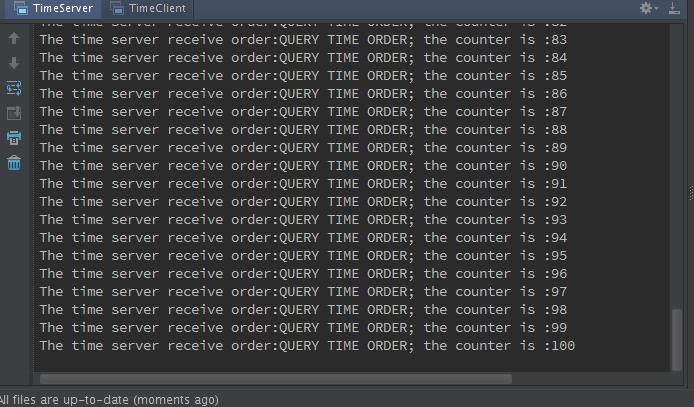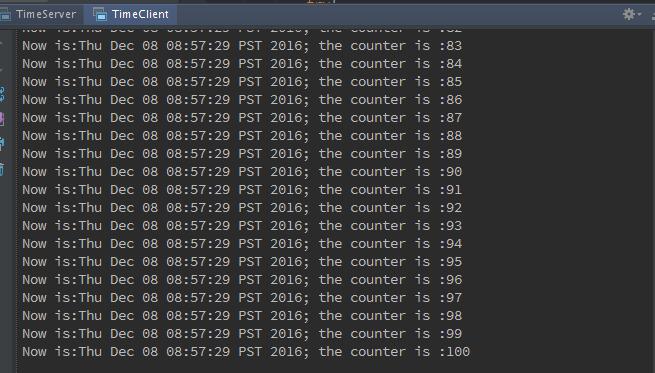Netty的TCP粘包/拆包(源码二)
假设客户端分别发送了两个数据包D1和D2给服务器,由于服务器端一次读取到的字节数是不确定的,所以可能发生四种情况:
1、服务端分两次读取到了两个独立的数据包,分别是D1和D2,没有粘包和拆包。
2、服务端一次接收到了两个数据包,D1和D2粘合在一起,被称为TCP粘包。
3、服务端分两次读取到了两个数据包,第一次读取到了完整的D1包和D2包的部分内容,第二次读取到了D2包的剩余内容,这被称为TCP拆包。
4、服务端分两次读取到了两个数据包,第一次读取到了D1包的部分内容D1_1,第二次读取到了D1包的剩余内容D1_2和D2包的整包。
如果此时服务端TCP接收滑窗非常小,而数据包D1和D2比较大,很有可能会发生第五种可能,即服务端分多次才能将D1和D2包接收完全,期间发生多次拆包。
那么在Netty中可使用LineBasedFrameDecoder和StringDecoder
LineBasedFrameDecoder的工作原理是一次遍历ByteBuf中的可读字节,判断看是否有"\n"或者"\r\n",如果有,就以此位置为结束位置,从可读索引到结束位置区间的字节就组成了一行。它是以换行符为结束标志的解码器,支持携带结束符或者不携带结束符两种解码方式,同时支持配置单行的最大长度。
StringDecoder将接收到的对象转换成字符串,然后继续调用后面的handler。
利用LineBasedFrameDecoder解决TCP粘包问题:
package netty; import io.netty.bootstrap.ServerBootstrap;
import io.netty.channel.ChannelFuture;
import io.netty.channel.ChannelInitializer;
import io.netty.channel.ChannelOption;
import io.netty.channel.EventLoopGroup;
import io.netty.channel.nio.NioEventLoopGroup;
import io.netty.channel.socket.SocketChannel;
import io.netty.channel.socket.nio.NioServerSocketChannel;
import io.netty.handler.codec.LineBasedFrameDecoder;
import io.netty.handler.codec.string.StringDecoder; public class TimeServer { public void bind(int port) throws Exception{
//配置服务端的NIO线程组
EventLoopGroup bossGroup = new NioEventLoopGroup();
EventLoopGroup workerGroup = new NioEventLoopGroup();
try{
ServerBootstrap b = new ServerBootstrap();
b.group(bossGroup,workerGroup)
.channel(NioServerSocketChannel.class)
.option(ChannelOption.SO_BACKLOG, 1024)
.childHandler(new ChildChannelHandler());
//绑定端口,同步等待成功
ChannelFuture f = b.bind(port).sync();
//等待服务器监听端口关闭
f.channel().closeFuture().sync();
}finally{
//优雅退出,释放线程池资源
bossGroup.shutdownGracefully();
workerGroup.shutdownGracefully();
}
} private class ChildChannelHandler extends ChannelInitializer<SocketChannel>{
@Override
protected void initChannel(SocketChannel arg0) throws Exception{
arg0.pipeline().addLast(new LineBasedFrameDecoder(1024));
42 arg0.pipeline().addLast(new StringDecoder());
arg0.pipeline().addLast(new TimeServerHandler());
}
} public static void main(String args[]) throws Exception{
int port = 10001;
if(args != null && args.length > 0){
try{
port = Integer.valueOf(args[0]);
}catch(NumberFormatException e){
//采用默认值
}
}
new TimeServer().bind(port);
}
}
TimeServerHandler, msg是删除回车换行符后的请求消息,不需要额外考虑处理半包问题,也不需要对请求消息进行编码:
import java.io.IOException;
import io.netty.buffer.ByteBuf;
import io.netty.buffer.Unpooled;
import io.netty.channel.ChannelHandlerAdapter;
import io.netty.channel.ChannelHandlerContext; public class TimeServerHandler extends ChannelHandlerAdapter{ private int counter; public void channelRead(ChannelHandlerContext ctx,Object msg) throws IOException{ String body = (String)msg;
System.out.println("The time server receive order:" + body + "; the counter is :" + ++counter);
String currentTime = "QUERY TIME ORDER".equalsIgnoreCase(body)? new java.util.Date(
System.currentTimeMillis()).toString() : "BAD ORDER";
currentTime = currentTime + System.getProperty("line.separator");
ByteBuf resp = Unpooled.copiedBuffer(currentTime.getBytes());
ctx.writeAndFlush(resp);
} public void channelReadComplete(ChannelHandlerContext ctx) throws Exception{
ctx.flush();
} @Override
public void exceptionCaught(ChannelHandlerContext ctx,Throwable cause){
ctx.close();
}
}
TimeClient,在TimeClientHandler之前新增lineBasedFrameDecoder和StringDecoder解码器:
import io.netty.bootstrap.Bootstrap;
import io.netty.channel.ChannelFuture;
import io.netty.channel.ChannelInitializer;
import io.netty.channel.ChannelOption;
import io.netty.channel.EventLoopGroup;
import io.netty.channel.nio.NioEventLoopGroup;
import io.netty.channel.socket.SocketChannel;
import io.netty.channel.socket.nio.NioSocketChannel;
import io.netty.handler.codec.LineBasedFrameDecoder;
import io.netty.handler.codec.string.StringDecoder; public class TimeClient { public void connect(int port,String host) throws Exception{
//创建客户端处理I/O读写的NioEventLoopGroup Group线程组
EventLoopGroup group = new NioEventLoopGroup();
try{
//创建客户端辅助启动类Bootstrap
Bootstrap b = new Bootstrap();
b.group(group).channel(NioSocketChannel.class)
.option(ChannelOption.TCP_NODELAY, true)
.handler(new ChannelInitializer<SocketChannel>(){
//将ChannelHandler设置到ChannelPipleline中,用于处理网络I/O事件
@Override
protected void initChannel(SocketChannel ch) throws Exception {
ch.pipeline().addLast(new LineBasedFrameDecoder(1024));
27 ch.pipeline().addLast(new StringDecoder());
ch.pipeline().addLast(new TimeClientHandler());
}
});
//发起异步连接操作,然后调用同步方法等待连接成功。
ChannelFuture f = b.connect(host,port).sync(); //等待客户端链路关闭
f.channel().closeFuture().sync();
}finally{
//优雅退出,释放NIO线程组
group.shutdownGracefully();
}
} public static void main(String[] args) throws Exception{
int port = 10001;
if(args != null && args.length > 0){
try{
port = Integer.valueOf(args[0]);
}catch(NumberFormatException e){
//采用默认值
}
}
new TimeClient().connect(port, "0.0.0.0");
} }
TimeClientHandler,拿到的msg已经是解码成字符串之后的应答消息:
import io.netty.buffer.ByteBuf;
import io.netty.buffer.Unpooled;
import io.netty.channel.ChannelHandlerAdapter;
import io.netty.channel.ChannelHandlerContext; import java.util.logging.Logger; public class TimeClientHandler extends ChannelHandlerAdapter{ private static final Logger logger = Logger.getLogger(TimeClientHandler.class.getName()); private int counter; private byte[]req; public TimeClientHandler(){
req = ("QUERY TIME ORDER" + System.getProperty("line.separator")).getBytes();
} //当客户端与服务端TCP链路简历成功后,Netty的NIO线程会调用该方法,发送查询时间的指令给服务器
public void channelActive(ChannelHandlerContext ctx){
//将请求消息发送给服务端
ByteBuf message = null;
for(int i = 0;i<100;i++){
message = Unpooled.buffer(req.length);
message.writeBytes(req);
ctx.writeAndFlush(message);
}
} //当服务器返回应答消息时,该方法被调用
public void channelRead(ChannelHandlerContext ctx,Object msg) throws Exception{
String body = (String)msg;
System.out.println("Now is:" + body + "; the counter is :" + ++counter);
} public void exceptionCaught(ChannelHandlerContext ctx,Throwable cause){ //释放资源
logger.warning("Unexpected exception from downstream :" + cause.getMessage());
ctx.close();
}
}
运行结果:


发现。。就木有粘包或拆包的问题啦~~~~
机缘巧合,同事也一起实现了Scala版~
clientHandler:
package main.nettyscala
import io.netty.buffer.{ByteBuf, Unpooled}
import io.netty.channel.{ChannelInboundHandlerAdapter, ChannelHandlerContext, ChannelHandlerAdapter}
/**
* Created by root on 2016/11/18.
*/
class ClientHandler extends ChannelInboundHandlerAdapter {
override def channelActive(ctx: ChannelHandlerContext): Unit = {
println("channelActive")
//val content = "hello server"
val content = Console.readLine()
ctx.writeAndFlush(Unpooled.copiedBuffer(content.getBytes("UTF-8")))
//发送case class 不在发送字符串了,封装一个字符串
// ctx.writeAndFlush(RegisterMsg("hello server"))
}
override def channelRead(ctx: ChannelHandlerContext, msg: scala.Any): Unit = {
println("channelRead")
val byteBuf = msg.asInstanceOf[ByteBuf]
val bytes = new Array[Byte](byteBuf.readableBytes())
byteBuf.readBytes(bytes)
val message = new String(bytes, "UTF-8")
println(message)
}
override def channelReadComplete(ctx: ChannelHandlerContext): Unit = {
println("channeReadComplete")
ctx.flush()
}
//发送异常时关闭
override def exceptionCaught(ctx: ChannelHandlerContext, cause: Throwable): Unit = {
println("exceptionCaught")
ctx.close()
}
}
NettyClient:
package main.nettyscala import io.netty.bootstrap.Bootstrap
import io.netty.channel.ChannelInitializer
import io.netty.channel.nio.NioEventLoopGroup
import io.netty.channel.socket.SocketChannel
import io.netty.channel.socket.nio.{NioSocketChannel, NioServerSocketChannel}
import io.netty.handler.codec.serialization.{ClassResolvers, ObjectDecoder, ObjectEncoder} object NettyClient {
def main(args: Array[String]) {
val host = args(0)
val port = args(1).toInt
val client = new NettyClient
client.connect(host, port)
}
} class NettyClient {
def connect(host: String, port: Int): Unit = {
//创建客户端NIO线程组
val eventGroup = new NioEventLoopGroup
//创建客户端辅助启动类
val bootstrap = new Bootstrap
try {
//将NIO线程组传入到Bootstrap
bootstrap.group(eventGroup)
//创建NioSocketChannel
.channel(classOf[NioSocketChannel])
//绑定I/O事件处理类
.handler(new ChannelInitializer[SocketChannel] {
override def initChannel(ch: SocketChannel): Unit = {
ch.pipeline().addLast(
// new ObjectEncoder,
// new ObjectDecoder(ClassResolvers.cacheDisabled(getClass.getClassLoader)),
new ClientHandler
)
}
})
//发起异步连接操作
val channelFuture = bootstrap.connect(host, port).sync()
//等待服务关闭
channelFuture.channel().closeFuture().sync()
} finally {
//优雅的退出,释放线程池资源
eventGroup.shutdownGracefully()
}
}
}
NettyServer:
package main.nettyscala /**
* Created by root on 12/8/16.
*/
import io.netty.bootstrap.ServerBootstrap
import io.netty.channel.ChannelInitializer
import io.netty.channel.nio.NioEventLoopGroup
import io.netty.channel.socket.SocketChannel
import io.netty.channel.socket.nio.NioServerSocketChannel
import io.netty.handler.codec.serialization.{ClassResolvers, ClassResolver, ObjectDecoder, ObjectEncoder} object NettyServer {
def main(args: Array[String]) {
val host = args(0)
val port = args(1).toInt
val server = new NettyServer
server.bind(host, port)
}
}
class NettyServer {
def bind(host: String, port: Int): Unit = {
//配置服务端线程池组
//用于服务器接收客户端连接
val bossGroup = new NioEventLoopGroup()
//用户进行SocketChannel的网络读写
val workerGroup = new NioEventLoopGroup() try {
//是Netty用户启动NIO服务端的辅助启动类,降低服务端的开发复杂度
val bootstrap = new ServerBootstrap()
//将两个NIO线程组作为参数传入到ServerBootstrap
bootstrap.group(bossGroup, workerGroup)
//创建NioServerSocketChannel
.channel(classOf[NioServerSocketChannel])
//绑定I/O事件处理类
.childHandler(new ChannelInitializer[SocketChannel] {
override def initChannel(ch: SocketChannel): Unit = {
ch.pipeline().addLast(
// new ObjectEncoder,
// new ObjectDecoder(ClassResolvers.cacheDisabled(getClass.getClassLoader)),
new ServerHandler
)
}
})
//绑定端口,调用sync方法等待绑定操作完成
val channelFuture = bootstrap.bind(host, port).sync()
//等待服务关闭
channelFuture.channel().closeFuture().sync()
} finally {
//优雅的退出,释放线程池资源
bossGroup.shutdownGracefully()
workerGroup.shutdownGracefully()
}
}
}
ServerHandler:
package main.nettyscala /**
* Created by root on 12/8/16.
*/
import io.netty.buffer.{Unpooled, ByteBuf}
import io.netty.channel.{ChannelHandlerContext, ChannelInboundHandlerAdapter} /**
* Created by root on 2016/11/18.
*/
class ServerHandler extends ChannelInboundHandlerAdapter {
/**
* 有客户端建立连接后调用
*/
override def channelActive(ctx: ChannelHandlerContext): Unit = {
println("channelActive invoked")
} /**
* 接受客户端发送来的消息
*/
override def channelRead(ctx: ChannelHandlerContext, msg: scala.Any): Unit = {
println("channelRead invoked")
val byteBuf = msg.asInstanceOf[ByteBuf]
val bytes = new Array[Byte](byteBuf.readableBytes())
byteBuf.readBytes(bytes)
val message = new String(bytes, "UTF-8")
println(message)
val back = "received message: " + message
val resp = Unpooled.copiedBuffer(back.getBytes("UTF-8"))
println(msg)
ctx.write(resp)
} /**
* 将消息对列中的数据写入到SocketChanne并发送给对方
*/
override def channelReadComplete(ctx: ChannelHandlerContext): Unit = {
println("channekReadComplete invoked")
ctx.flush()
} }
RegisterMsg:
package main.nettyscala /**
* Created by root on 12/8/16.
*/
case class RegisterMsg(content: String) extends Serializable
运行结果:


Netty的TCP粘包/拆包(源码二)的更多相关文章
- netty之==TCP粘包/拆包问题解决之道(一)
一.TCP粘包/拆包是什么 TCP是一个“流”协议,所谓流,就是没有界限的一长串二进制数据.TCP作为传输层协议并不不了解上层业务数据的具体含义,它会根据TCP缓冲区的实际情况进行数据包的划分,所以在 ...
- 1. Netty解决Tcp粘包拆包
一. TCP粘包问题 实际发送的消息, 可能会被TCP拆分成很多数据包发送, 也可能把很多消息组合成一个数据包发送 粘包拆包发生的原因 (1) 应用程序一次写的字节大小超过socket发送缓冲区大小 ...
- Netty TCP粘包/拆包问题《二》
1.DelimiterBasedFrameDecoder:是以分隔符作为结束标志进行解决粘包/拆包问题 代码: EchoClient:客户端 /* * Copyright 2012 The Netty ...
- Netty解决TCP粘包/拆包问题 - 按行分隔字符串解码器
服务端 package org.zln.netty.five.timer; import io.netty.bootstrap.ServerBootstrap; import io.netty.cha ...
- 深入学习Netty(5)——Netty是如何解决TCP粘包/拆包问题的?
前言 学习Netty避免不了要去了解TCP粘包/拆包问题,熟悉各个编解码器是如何解决TCP粘包/拆包问题的,同时需要知道TCP粘包/拆包问题是怎么产生的. 在此博文前,可以先学习了解前几篇博文: 深入 ...
- Netty(三)TCP粘包拆包处理
tcp是一个“流”的协议,一个完整的包可能会被TCP拆分成多个包进行发送,也可能把小的封装成一个大的数据包发送,这就是所谓的TCP粘包和拆包问题. 粘包.拆包问题说明 假设客户端分别发送数据包D1和D ...
- Netty(二)——TCP粘包/拆包
转载请注明出处:http://www.cnblogs.com/Joanna-Yan/p/7814644.html 前面讲到:Netty(一)--Netty入门程序 主要内容: TCP粘包/拆包的基础知 ...
- Netty使用LineBasedFrameDecoder解决TCP粘包/拆包
TCP粘包/拆包 TCP是个”流”协议,所谓流,就是没有界限的一串数据.TCP底层并不了解上层业务数据的具体含义,它会根据TCP缓冲区的实际情况进行包的划分,所以在业务上认为,一个完整的包可能会被TC ...
- TCP粘包/拆包(Netty权威指南)
无论是服务端还是客户端,当我们读取或者发送消息的时候,都需要考虑TCP底层的粘包/拆包机制. TCP粘包/拆包 TCP是个“流”协议,所谓流,就是没有界限的一串数据.大家可以想想河里的流水,是连成一片 ...
随机推荐
- flash2x、flax
http://flax.so/ 牛客网 LeetCode Online Judge
- tableView的高度问题
新建tableView 到一个普通的视图控制器的View 下,如果大小是全屏高 ,你的数据最下面显示不全,需要在设置高度时候,用屏幕高度-65 即可
- caffe 基本知识简介
很多不错的网页: 1.http://alanse7en.github.io/caffedai-ma-jie-xi-1/ 主要介绍基本caffe知识 interace 接口 API中的‘I’ Caffe ...
- Huffman编码(测试源代码)
1.此程序为c++程序 2.以下代码可实现手动输入,即去掉代码中的/*...*/注释符,并同时去掉赋值代码段 3.源代码 #include<iostream> using namespac ...
- c# 强制转换, 隐式转换, 显式转换
using System;using System.Collections.Generic;using System.Linq;using System.Text;using System.Threa ...
- 将对象序列化,反序列化到XML
using System; using System.Collections.Generic; using System.IO; using System.Linq; using System.Tex ...
- 隐藏UITableView多余的分割线
先看看没有隐藏是什么效果以及代码是什么情况,这样更加直观
- http中get和post的区别
HTTP定义了与服务器交互的不同方法,最基本的方法是 GET 和 POST. HTTP-GET和HTTP-POST是使用HTTP的标准协议动词,用于编码和传送变量名/变量值对参数,并且使用相关的请求语 ...
- PHP Web Shell in browser
/************************************************************************************* * PHP Web She ...
- 《The Evolution of Lua》翻译part 2
Lua2 1990年的时候,面向对象迈向巅峰,对于Lua没有面向对象的支持,我们受到了很大的压力.我们不想将Lua变成面向对象,因为我们不想“修复”一种编程范式(fix a programming p ...
